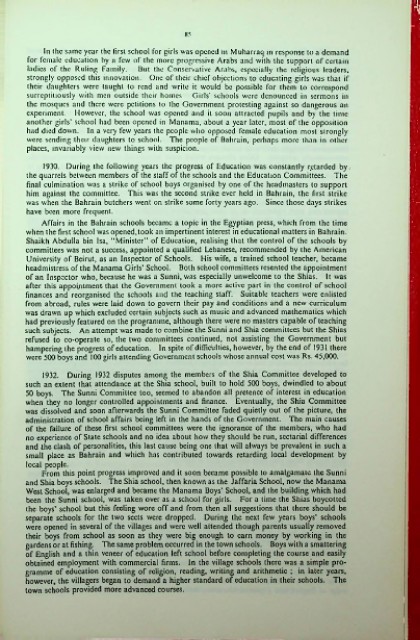Page 429 - Bahrain Gov annual reports(V)_Neat
P. 429
85
In the same year the first school for girls was opened in Muharraq in response to a demand
for female education by a few of the more progressive Arabs and with the support of certain
ladies of the Ruling Family. But the Conservative Arabs, especially the religious leaders,
strongly opposed this innovation. One of their chief objections to educating girls was that if
their daughters were taught to read and write it would be possible for them to correspond
surreptitiously with men outside their homes. Girls’ schools were denounced in sermons in
the mosques and there were petitions to the Government protesting against so dangerous an
experiment. However, the school was opened and it soon attracted pupils and by the time
another girls’ school had been opened in Manama, about a year later, most of the opposition
had died down. In a very few years the people who opposed female education most strongly
were sending their daughters to school. The people of Bahrain, perhaps more than in other
places, invariably view new things with suspicion.
1930. During the following years the progress of Education was constantly retarded by
the quarrels between members of the staff of the schools and the Education Committees. The
final culmination was a strike of school boys organised by one of the headmasters to support
him against the committee. This was the second strike ever held in Bahrain, the first strike
was when the Bahrain butchers went on strike some forty years ago. Since those days strikes
have been more frequent.
Affairs in the Bahrain schools became a topic in the Egyptian press, which from the time
when the first school was opened, took an impertinent interest in educational matters in Bahrain.
Shaikh Abdulla bin Isa, “Minister” of Education, realising that the control of the schools by
committees was not a success, appointed a qualified Lebanese, recommended by the American
University of Beirut, as an Inspector of Schools. His wife, a trained school teacher, became
headmistress of the Manama Girls’ School. Both school committees resented the appointment
of an Inspector who, because he was a Sunni, was especially unwelcome to the Shias. It was
after this appointment that the Government took a more active part in the control of school
finances and reorganised the schools and the teaching staff. Suitable teachers were enlisted
from abroad, rules were laid down to govern their pay and conditions and a new curriculum
was drawn up which excluded certain subjects such as music and advanced mathematics which
had previously featured on the programme, although there were no masters capable of teaching
such subjects. An attempt was made to combine the Sunni and Shia committees but the Shias
refused to co-operate so, the two committees continued, not assisting the Government but
hampering the progress of education. In spite of difficulties, however, by the end of 1931 there
were 500 boys and 100 girls attending Government schools whose annual cost was Rs. 45,000.
1932. During 1932 disputes among the members of the Shia Committee developed to
such an extent that attendance at the Shia school, built to hold 500 boys, dwindled to about
50 boys. The Sunni Committee too, seemed to abandon all pretence of interest in education
when they no longer controlled appointments and finance. Eventually, the Shia Committee
was dissolved and soon afterwards the Sunni Committee faded quietly out of the picture, the
administration of school affairs being left in the hands of the Government. The main causes
of the failure of these first school committees were the ignorance of the members, who had
no experience of State schools and no idea about how they should be run, scctarial differences
and the clash of personalities, this last cause being one that will always be prevalent in such a
small place as Bahrain and which has contributed towards retarding local development by
local people.
From this point progress improved and it soon became possible to amalgamate the Sunni
and Shia boys schools. The Shia school, then known as the Jaffaria School, now the Manama
West School, was enlarged and became the Manama Boys’ School, and the building which had
been the Sunni school, was taken over as a school for girls. For a time the Shias boycotted
the boys’ school but this feeling wore off and from then all suggestions that there should be
separate schools for the two sects were dropped. During the next few years boys’ schools
were opened in several of the villages and were well attended though parents usually removed
their boys from school as soon as they were big enough to cam money by working in the
gardens or at fishing. The same problem occurred in the town schools. Boys with a smattering
of English and a thin veneer of education left school before completing the course and easily
obtained employment with commercial firms. In the village schools there was a simple pro
gramme of education consisting of religion, reading, writing and arithmetic ; in later years,
however, the villagers began to demand a higher standard of education in their schools. The
town schools provided more advanced courses.
i

